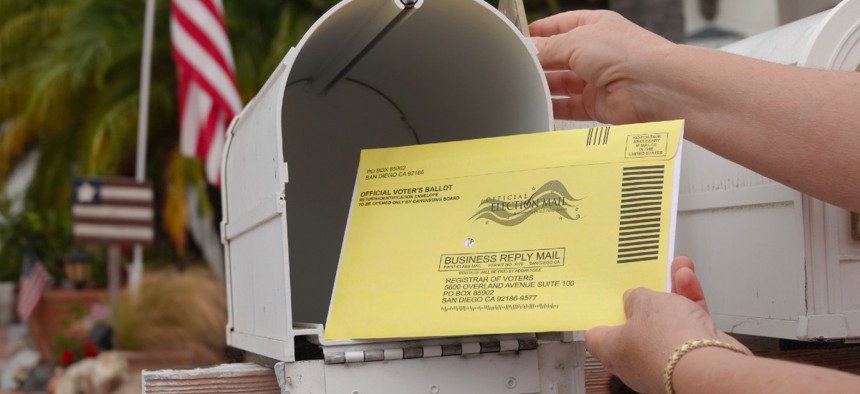5 Lessons Learned as the CISO for the U.S. Postal Service

Simone Hogan/istockphoto.com
Agencies cannot stop hackers from targeting them. But we can—and should—develop risk management strategies.
While serving as the chief information security officer for the U.S. Postal Service from 2015 through March of this year, I developed a great appreciation and respect for the critical role the agency performs for our nation. During the 2020 election, in particular, the magnitude of our mission hit home every day.
At the time, the Postal Service was responsible for the receipt and delivery of 70 million mailed voting ballots. As a result, the protection of our IT network—one of the largest in the world—was in the national spotlight and emerged as more essential than ever. Innovation makes this entire process possible, with operational technology (OT) in the form of automation-enabled mail processing equipment spanning up to the length of half a football field in huge warehouses located throughout the country.
We were aware that nation state adversaries were seeking to sabotage the election and could attempt to do so by hacking these systems and machines. But our cybersecurity and IT teams at the Postal Service rose to the occasion, demonstrated vigilance and ensured the on-time delivery of those ballots.
This unwavering dedication illustrates the vital role that the Postal Service continues to play for the American people. USPS is a government organization that originated just as our nation marched toward independence: On July 26, 1775, the Second Continental Congress appointed Benjamin Franklin as the first Postmaster General at a salary of $1,000 a year. Today, USPS employs 644,000 workers and processes nearly 300,000 pieces of mail per minute.
From an IT and cybersecurity perspective, the Postal Service:
- Supports the secure connection to over 260,000 mobile delivery devices, 152,000 computers, 46,000 point-of-sale terminals, 2,700 self-service retail kiosks and 31,000 facilities.
- Oversees 92.5 petabytes of storage capacity.
- Manages over 216,000 email accounts, receiving over 5.3 million legitimate emails a day while blocking over two million emails monthly containing spam and malware.
- Owns 1,884 internet domains.
I took from my time as CISO the following lessons learned—lessons that can benefit any government agency:
Enterprise risk management requires the commitment of all leaders. We can’t think of the protection of data, systems, networks and devices as strictly “a cybersecurity thing.” At USPS, we formed an executive committee—called the Executive Cyber Risk Committee or ECRC—with participation from our CEO (the Postmaster General), CIO, CFO and other top officers from across the organization. We were intensely focused on the most important cyber risks that could impact our business, our people, and our customers. This engagement with the ECRC ensured that our cybersecurity team received the level of financial investment and organizational commitment needed to implement technology controls to secure our digital assets.
A comprehensive IT inventory serves as the foundation of any successful cybersecurity strategy. The long-time adage, “You can’t protect what you don’t know and cannot see,” still holds true. Agencies need to have a complete and accurate inventory on hand of every digital asset within their organization. From there, they must implement controls (such as network access controls) and have the capability to monitor all these assets 24/7/365.
OT and internet of things systems require total visibility. During my time as CISO for USPS, it became increasingly apparent that we had opportunities when it came to securing the OT and IoT-enabled parts of our organization. We worked to establish 100% visibility throughout all OT equipment and IoT systems (such as the mail processors) regardless of their network infrastructure or device type. Once we acquired continuous, real-time visibility, we were able to classify OT and connected devices across heterogeneous device types and network tiers, leading directly to the deployment of rich, contextual intelligence for accurate asset management and incident prioritization.
You are only as strong as your third-party suppliers/partners. This applies especially to government agencies (such as the Postal Service) that are not in the technology business and depend upon the support of outside IT vendors. More than one-half of organizations have experienced a data breach caused by a third party. To mitigate this risk at USPS, I worked closely with the head of supply management to review our contracts and took an aggressive stand in conducting due diligence of our suppliers to verify that their risk management practices met our standards.
“Keep your friends close. Keep your enemies closer.” This classic line from Michael Corleone in the film, “Godfather II,” has never been more relevant, given the malicious intentions of nation-state adversaries. I spent 25 years in the U.S. Postal Inspection Service, which gave me a strong sense of situational awareness about what criminals can do. Today, this type of situational awareness must extend to actors working on behalf of foreign countries who seek to steal our information, disrupt our operations and otherwise keep us from achieving our missions.
Agencies cannot stop hackers from targeting them. But we can—and should—develop risk management strategies based upon lessons like these. In doing so, we can ensure the protection of our digital assets and uninterrupted performance of our mission-critical duties, whether delivering millions of election ballots or a single letter.
Indeed, with these lessons incorporated into our cybersecurity strategies, we can move forward with confidence that (as the traditional saying about our postal carriers goes) “neither snow nor rain nor heat nor gloom of night”—nor hackers—will keep us from the swift completion of our appointed rounds and delivering on our promise to the American people.
Greg Crabb is a Forescout strategic adviser and former chief information security officer for the United States Postal Service.





